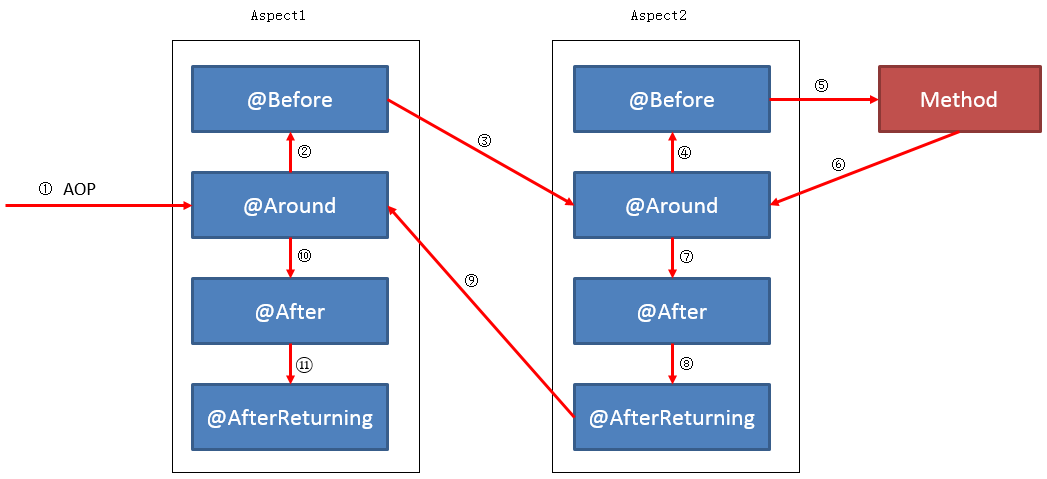Spring Aop实例@Aspect、@Before、@AfterReturning@Around 注解方式配置(转)
用过spring框架进行开发的人,多多少少会使用过它的AOP功能,都知道有@Before、@Around和@After等advice。最近,为了实现项目中的输出日志和权限控制这两个需求,我也使用到了AOP功能。我使用到了@Before、@Around这两个advice。但在,使用过程中,却对它们的执行顺序并不清楚。为了弄清楚在不同情况下,这些advice到底是以怎么样的一个顺序进行执行的,我作了个测试,在此将其记录下来,以供以后查看。
前提
- 对于AOP相关类(aspect、pointcut等)的概念,本文不作说明。
- 对于如何让spring框架扫描到AOP,本文也不作说明。
情况一: 一个方法只被一个Aspect类拦截
当一个方法只被一个Aspect拦截时,这个Aspect中的不同advice是按照怎样的顺序进行执行的呢?请看:
添加 PointCut类
该pointcut用来拦截test包下的所有类中的所有方法。
package test;
import org.aspectj.lang.annotation.Pointcut;
public class PointCuts {
@Pointcut(value = "within(test.*)")
public void aopDemo() {
}
}
- package test; import org.aspectj.lang.annotation.Pointcut; public class PointCuts { @Pointcut(value = "within(test.*)") public void aopDemo() { } }
添加Aspect类
该类中的advice将会用到上面的pointcut,使用方法请看各个advice的value属性。
package test; import org.aspectj.lang.JoinPoint;
import org.aspectj.lang.ProceedingJoinPoint;
import org.aspectj.lang.annotation.*;
import org.springframework.stereotype.Component; @Component
@Aspect
public class Aspect1 { @Before(value = "test.PointCuts.aopDemo()")
public void before(JoinPoint joinPoint) {
System.out.println("[Aspect1] before advise");
} @Around(value = "test.PointCuts.aopDemo()")
public void around(ProceedingJoinPoint pjp) throws Throwable{
System.out.println("[Aspect1] around advise 1");
pjp.proceed();
System.out.println("[Aspect1] around advise2");
} @AfterReturning(value = "test.PointCuts.aopDemo()")
public void afterReturning(JoinPoint joinPoint) {
System.out.println("[Aspect1] afterReturning advise");
} @AfterThrowing(value = "test.PointCuts.aopDemo()")
public void afterThrowing(JoinPoint joinPoint) {
System.out.println("[Aspect1] afterThrowing advise");
} @After(value = "test.PointCuts.aopDemo()")
public void after(JoinPoint joinPoint) {
System.out.println("[Aspect1] after advise");
}
}
添加测试用Controller
添加一个用于测试的controller,这个controller中只有一个方法,但是它会根据参数值的不同,会作出不同的处理:一种是正常返回一个对象,一种是抛出异常(因为我们要测试@AfterThrowing这个advice)
package test; import test.exception.TestException;
import org.springframework.http.HttpStatus;
import org.springframework.web.bind.annotation.*; @RestController
@RequestMapping(value = "/aop")
public class AopTestController { @ResponseStatus(HttpStatus.OK)
@RequestMapping(value = "/test", method = RequestMethod.GET)
public Result test(@RequestParam boolean throwException) {
// case 1
if (throwException) {
System.out.println("throw an exception");
throw new TestException("mock a server exception");
} // case 2
System.out.println("test OK");
return new Result() {{
this.setId(111);
this.setName("mock a Result");
}};
} public static class Result {
private int id;
private String name; public int getId() {
return id;
} public void setId(int id) {
this.id = id;
} public String getName() {
return name;
} public void setName(String name) {
this.name = name;
}
}
}
测试 正常情况
在浏览器直接输入以下的URL,回车:
http://192.168.142.8:7070/aoptest/v1/aop/test?throwException=false我们会看到输出的结果是:
[Aspect1] around advise 1
[Aspect1] before advise
test OK
[Aspect1] around advise2
[Aspect1] after advise
[Aspect1] afterReturning advise
测试 异常情况
在浏览器中直接输入以下的URL,回车:
http://192.168.142.8:7070/aoptest/v1/aop/test?throwException=true
我们会看到输出的结果是:
- [Aspect1] around advise 1
- [Aspect1] before advise
- throw an exception
- [Aspect1] after advise
- [Aspect1] afterThrowing advise
结论
在一个方法只被一个aspect类拦截时,aspect类内部的 advice 将按照以下的顺序进行执行:
正常情况: 

情况二: 同一个方法被多个Aspect类拦截
此处举例为被两个aspect类拦截。
有些情况下,对于两个不同的aspect类,不管它们的advice使用的是同一个pointcut,还是不同的pointcut,都有可能导致同一个方法被多个aspect类拦截。那么,在这种情况下,这多个Aspect类中的advice又是按照怎样的顺序进行执行的呢?请看:
pointcut类保持不变
添加一个新的aspect类
package test; import org.aspectj.lang.JoinPoint;
import org.aspectj.lang.ProceedingJoinPoint;
import org.aspectj.lang.annotation.*;
import org.springframework.stereotype.Component; @Component
@Aspect
public class Aspect2 { @Before(value = "test.PointCuts.aopDemo()")
public void before(JoinPoint joinPoint) {
System.out.println("[Aspect2] before advise");
} @Around(value = "test.PointCuts.aopDemo()")
public void around(ProceedingJoinPoint pjp) throws Throwable{
System.out.println("[Aspect2] around advise 1");
pjp.proceed();
System.out.println("[Aspect2] around advise2");
} @AfterReturning(value = "test.PointCuts.aopDemo()")
public void afterReturning(JoinPoint joinPoint) {
System.out.println("[Aspect2] afterReturning advise");
} @AfterThrowing(value = "test.PointCuts.aopDemo()")
public void afterThrowing(JoinPoint joinPoint) {
System.out.println("[Aspect2] afterThrowing advise");
} @After(value = "test.PointCuts.aopDemo()")
public void after(JoinPoint joinPoint) {
System.out.println("[Aspect2] after advise");
}
}
测试用Controller也不变
还是使用上面的那个Controller。但是现在 aspect1 和 aspect2 都会拦截该controller中的方法。
下面继续进行测试!
测试 正常情况
在浏览器直接输入以下的URL,回车:
http://192.168.142.8:7070/aoptest/v1/aop/test?throwException=false
我们会看到输出的结果是:
[Aspect2] around advise 1
[Aspect2] before advise
[Aspect1] around advise 1
[Aspect1] before advise
test OK
[Aspect1] around advise2
[Aspect1] after advise
[Aspect1] afterReturning advise
[Aspect2] around advise2
[Aspect2] after advise
[Aspect2] afterReturning advise
但是这个时候,我不能下定论说 aspect2 肯定就比 aspect1 先执行。
不信?你把服务务器重新启动一下,再试试,说不定你就会看到如下的执行结果:
- [Aspect1] around advise 1
- [Aspect1] before advise
- [Aspect2] around advise 1
- [Aspect2] before advise
- test OK
- [Aspect2] around advise2
- [Aspect2] after advise
- [Aspect2] afterReturning advise
- [Aspect1] around advise2
- [Aspect1] after advise
- [Aspect1] afterReturning advise
也就是说,这种情况下, aspect1 和 aspect2 的执行顺序是未知的。那怎么解决呢?不急,下面会给出解决方案。
测试 异常情况
在浏览器中直接输入以下的URL,回车:
http://192.168.142.8:7070/aoptest/v1/aop/test?throwException=true
我们会看到输出的结果是:
- [Aspect2] around advise 1
- [Aspect2] before advise
- [Aspect1] around advise 1
- [Aspect1] before advise
- throw an exception
- [Aspect1] after advise
- [Aspect1] afterThrowing advise
- [Aspect2] after advise
- [Aspect2] afterThrowing advise
同样地,如果把服务器重启,然后再测试的话,就可能会看到如下的结果:
- [Aspect1] around advise 1
- [Aspect1] before advise
- [Aspect2] around advise 1
- [Aspect2] before advise
- throw an exception
- [Aspect2] after advise
- [Aspect2] afterThrowing advise
- [Aspect1] after advise
- [Aspect1] afterThrowing advise
也就是说,同样地,异常情况下, aspect1 和 aspect2 的执行顺序也是未定的。
那么在 情况二 下,如何指定每个 aspect 的执行顺序呢?
方法有两种:
- 实现org.springframework.core.Ordered接口,实现它的getOrder()方法
- 给aspect添加@Order注解,该注解全称为:org.springframework.core.annotation.Order
不管采用上面的哪种方法,都是值越小的 aspect 越先执行。
比如,我们为 apsect1 和 aspect2 分别添加 @Order 注解,如下:
- @Order(5)
- @Component
- @Aspect
- public class Aspect1 {
- // ...
- }
- @Order(6)
- @Component
- @Aspect
- public class Aspect2 {
- // ...
- }
这样修改之后,可保证不管在任何情况下, aspect1 中的 advice 总是比 aspect2 中的 advice 先执行。如下图所示:

注意点
如果在同一个 aspect 类中,针对同一个 pointcut,定义了两个相同的 advice(比如,定义了两个 @Before),那么这两个 advice 的执行顺序是无法确定的,哪怕你给这两个 advice 添加了 @Order 这个注解,也不行。这点切记。
对于@Around这个advice,不管它有没有返回值,但是必须要方法内部,调用一下 pjp.proceed();否则,Controller 中的接口将没有机会被执行,从而也导致了 @Before这个advice不会被触发。比如,我们假设正常情况下,执行顺序为”aspect2 -> apsect1 -> controller”,如果,我们把 aspect1中的@Around中的 pjp.proceed();给删掉,那么,我们看到的输出结果将是:
- [Aspect2] around advise 1
- [Aspect2] before advise
- [Aspect1] around advise 1
- [Aspect1] around advise2
- [Aspect1] after advise
- [Aspect1] afterReturning advise
- [Aspect2] around advise2
- [Aspect2] after advise
- [Aspect2] afterReturning advise
从结果可以发现, Controller 中的 接口 未被执行,aspect1 中的 @Before advice 也未被执行。
参考资料
- Spring 4.3.2.RELEASE 官方资料:http://docs.spring.io/spring/docs/current/spring-framework-reference/htmlsingle/
- 其中,AOP的执行顺序章节为:http://docs.spring.io/spring/docs/current/spring-framework-reference/htmlsingle/#aop-ataspectj-advice-ordering
Spring Aop实例@Aspect、@Before、@AfterReturning@Around 注解方式配置(转)的更多相关文章
- Spring Aop实例@Aspect、@Before、@AfterReturning@Around 注解方式配置
用过spring框架进行开发的人,多多少少会使用过它的AOP功能,都知道有@Before.@Around和@After等advice.最近,为了实现项目中的输出日志和权限控制这两个需求,我也使用到了A ...
- SSH深度历险(十) AOP原理及相关概念学习+AspectJ注解方式配置spring AOP
AOP(Aspect Oriented Programming),是面向切面编程的技术.AOP基于IoC基础,是对OOP的有益补充. AOP之所以能得到广泛应用,主要是因为它将应用系统拆分分了2个部分 ...
- Spring AOP 的@Aspect
Spring AOP 的@Aspect 转自:http://blog.csdn.net/tanghw/article/details/3862987 从Spring 2.0开始,可以使用基于sch ...
- 跟着刚哥学习Spring框架--通过注解方式配置Bean(四)
组件扫描:Spring能够从classpath下自动扫描,侦测和实例化具有特定注解的组件. 特定组件包括: 1.@Component:基本注解,识别一个受Spring管理的组件 2.@Resposit ...
- spring bean的介绍以及xml和注解的配置方法
5.Bean 下边我们来了解一下Bean的: Bean的作用域Bean的生命周期Bean的自动装配Resources和ResourceLoader 5.1Bean容器的初始化 Bean容器的初始化 两 ...
- Spring声明式事务管理(基于注解方式实现)
----------------------siwuxie095 Spring 声明式事务管理(基于注解方式实现) 以转 ...
- spring学习笔记 星球日two - 注解方式配置bean
注解要放在要注解的对象的上方 @Autowired private Category category; <?xml version="1.0" encoding=" ...
- Spring boot 基于注解方式配置datasource
Spring boot 基于注解方式配置datasource 编辑 Xml配置 我们先来回顾下,使用xml配置数据源. 步骤: 先加载数据库相关配置文件; 配置数据源; 配置sqlSessionF ...
- Spring配置文件中bean标签中init-method和destroy-method和用注解方式配置
Person类: public class Person { private int i = 0; public Person(){ System.o ...
随机推荐
- Ribbon【入门】
公共依赖: <parent> <groupId>org.springframework.boot</groupId> <artifactId>sprin ...
- (十三)自定义JSTL标签
前面的博客,我们讲过了 自定义 el函数 : 讲一个 自定义标签技术 : 目录 自定义标签 快速入门:使用标签输出客户机IP 关于标签处理器类的方法 自定义标签功能扩展 传统标签 简单标签 配置简单标 ...
- Visual studio 2010(VS2010) 安装MSDN方法
首先保证VS2010已经安装完毕 1.解压VS2010的安装文件(ISO),会看到ProductDocumentation文件夹,该文件夹下即为MSDN. 2.启动vs2010,点击"帮助& ...
- HADOOP 与 jupyterlab 链接
首先 咱们先把jdk1.0.0_60.tar.gz 和 hadoop-2.7.2.tar.gz 的压缩包放到root根目录下的opt文件夹下 如图: 然后 ...
- WUST Oracle数据库 实验一实验二
链接:https://pan.baidu.com/s/1hCzvTLzXhyItP2gD_69gzg 提取码:j68f 复制这段内容后打开百度网盘手机App,操作更方便哦
- S03_CH13_ZYNQ A9 TCP UART双核AMP例程
S03_CH13_ZYNQ A9 TCP UART双核AMP例程 13.1概述 ZYNQ中存在两个独立的ARM核,在很多应用场景中往往只需使用其中的1个核心即可.然而,对于复杂的设计,例如多任务,并行 ...
- k8s-部署策略
在Kubernetes中有几种不同的方式发布应用,所以为了让应用在升级期间依然平稳提供服务,选择一个正确的发布策略就非常重要了. 选择正确的部署策略是要依赖于我们的业务需求的,下面我们列出了一些可能会 ...
- c#重写了窗体的OnKeyDown事件,但是不执行
设置下窗体的KeyPreview属性值为True即可 总结:遇到类似这样的问题,比如其他窗体运行没问题,就新建的窗体有问题.应该检查下窗体的属性.
- 装机篇:将ubuntu 14.04安装在移动硬盘中
这样做有诸多好处,最大的好处莫过于获得新鲜感. 需要注意的只有一点,要把bootloader装在整个硬盘的MBR而不是单独某个分区的DBR里. 另,我所成功的版本为14.04.1,之前使用14.04. ...
- 页面使用element-tree
<!DOCTYPE html> <html lang="en"> <head> <meta charset="UTF-8&quo ...
